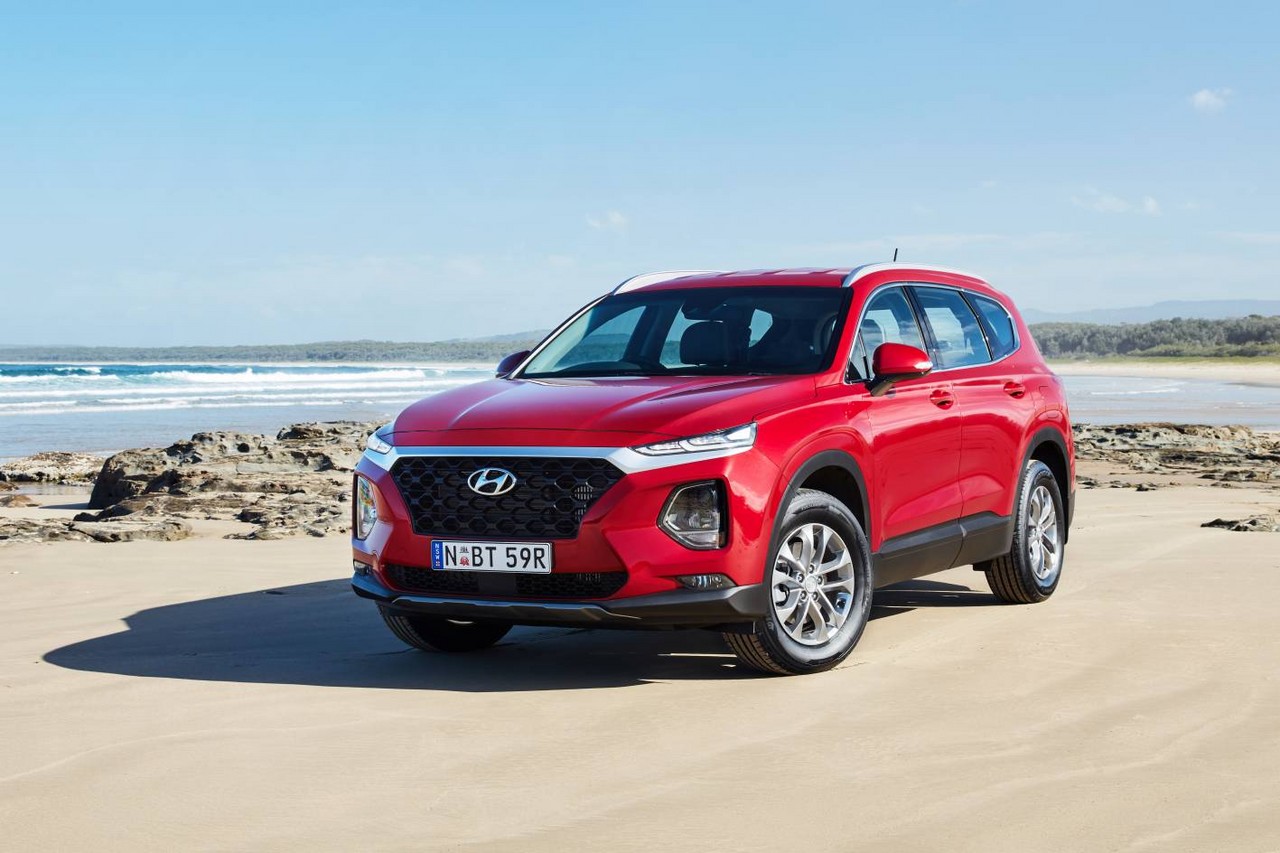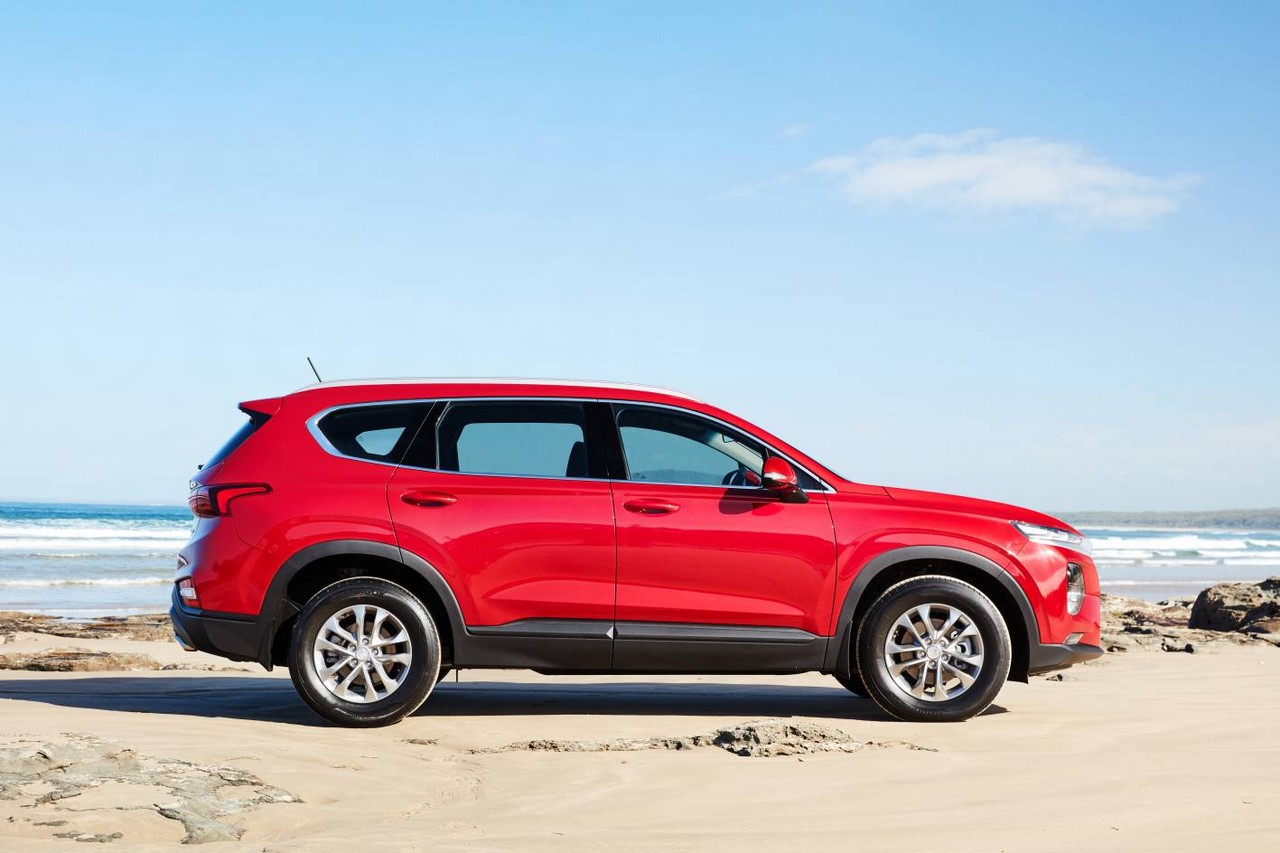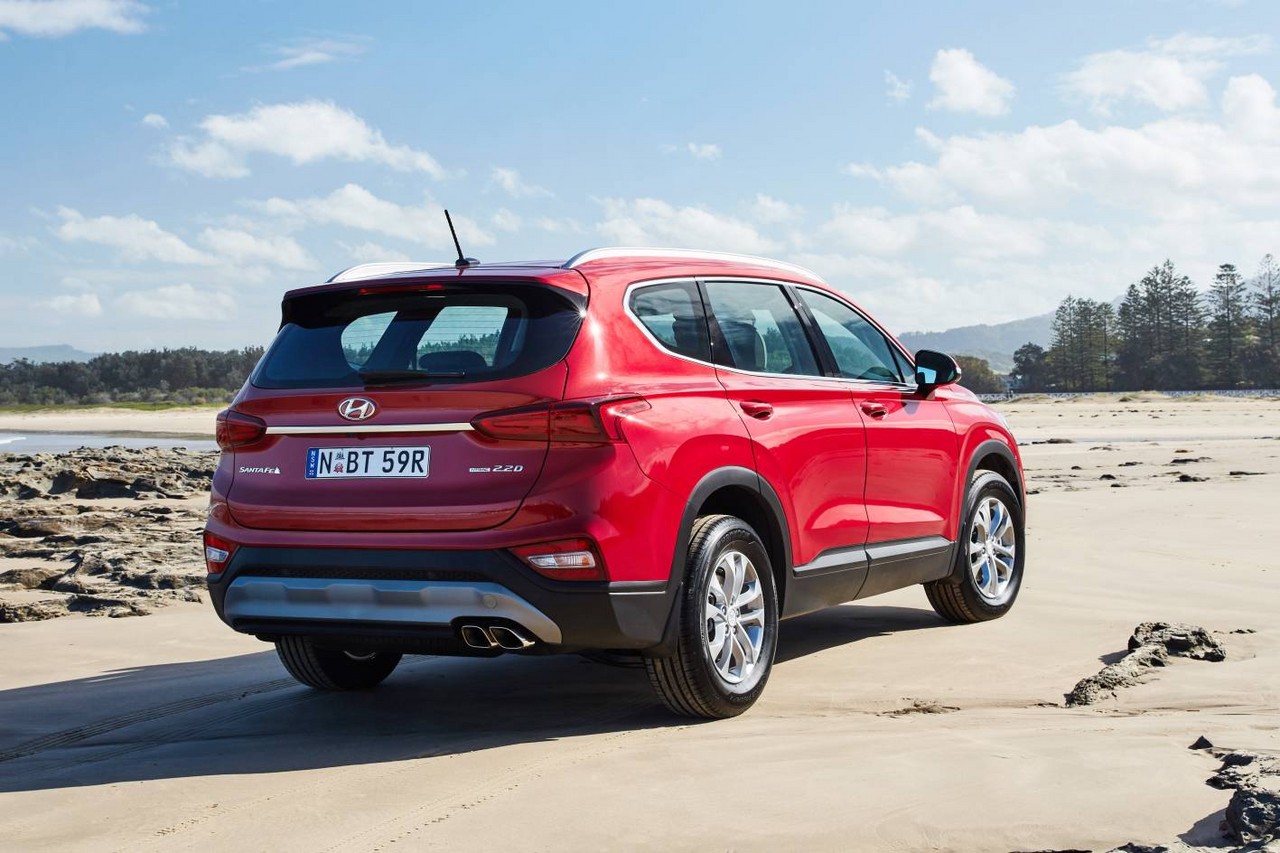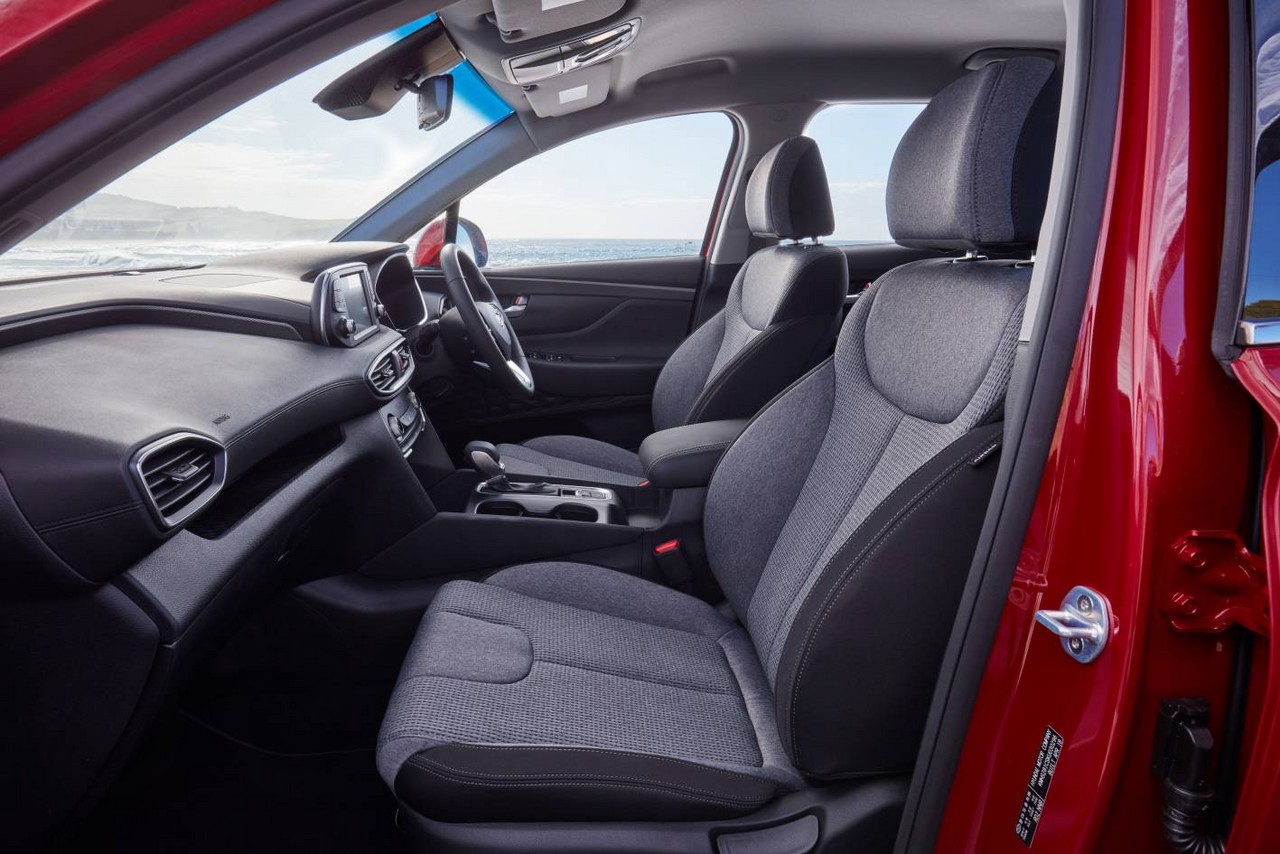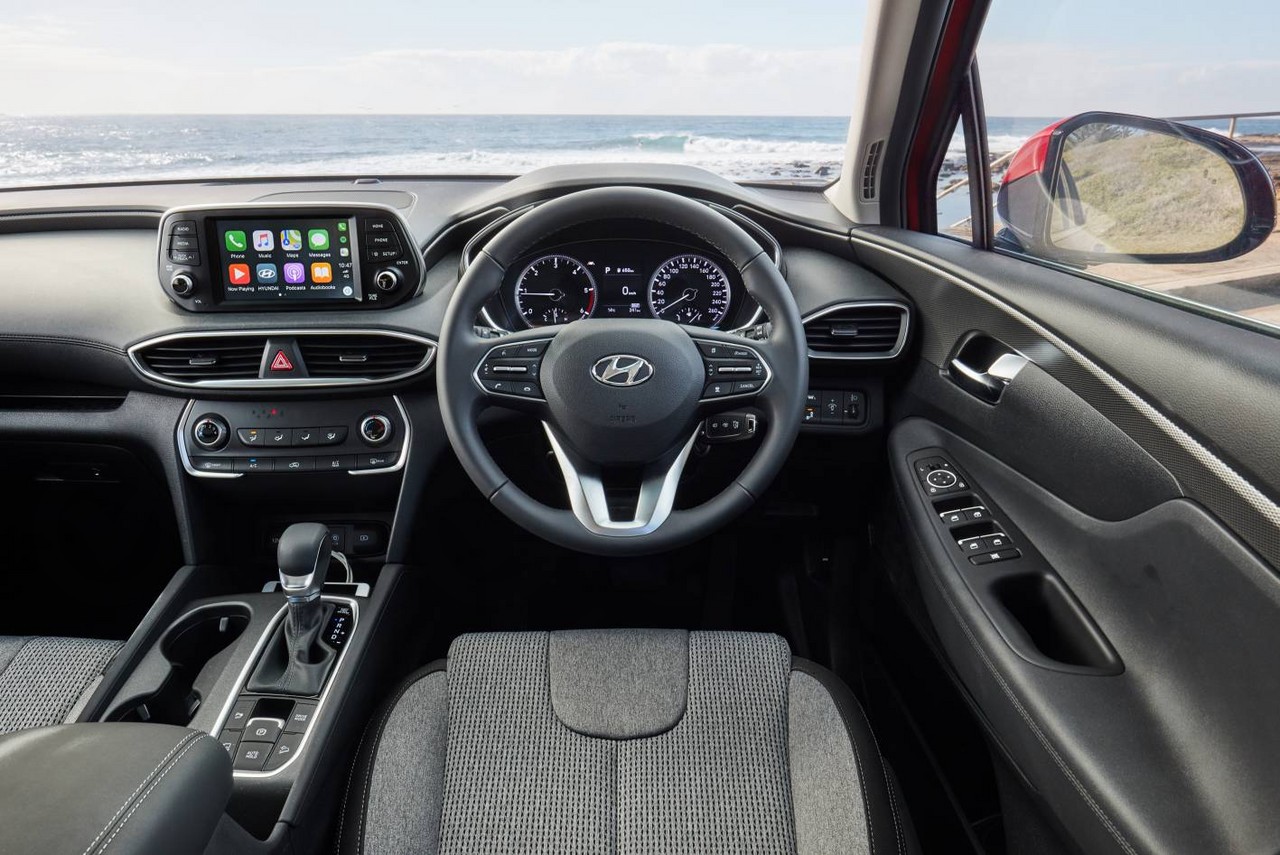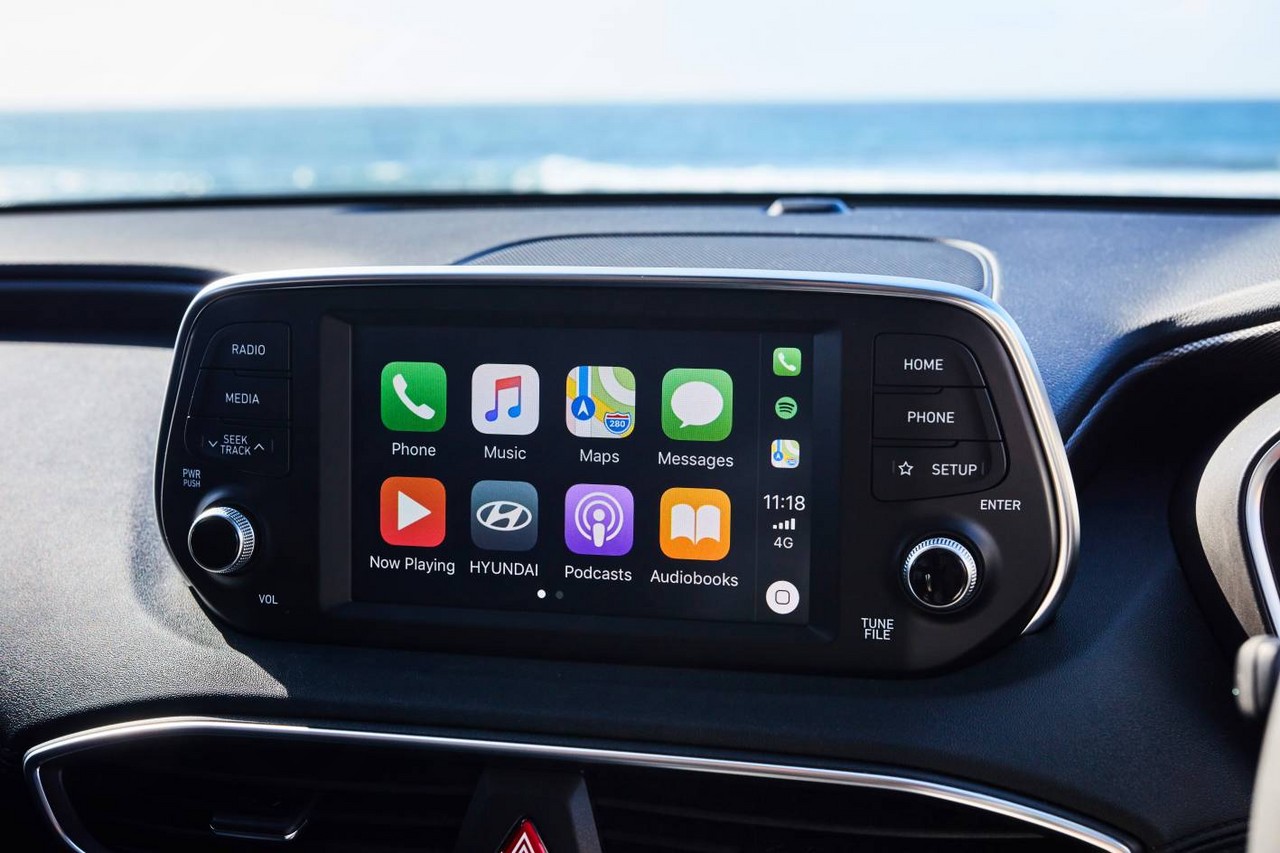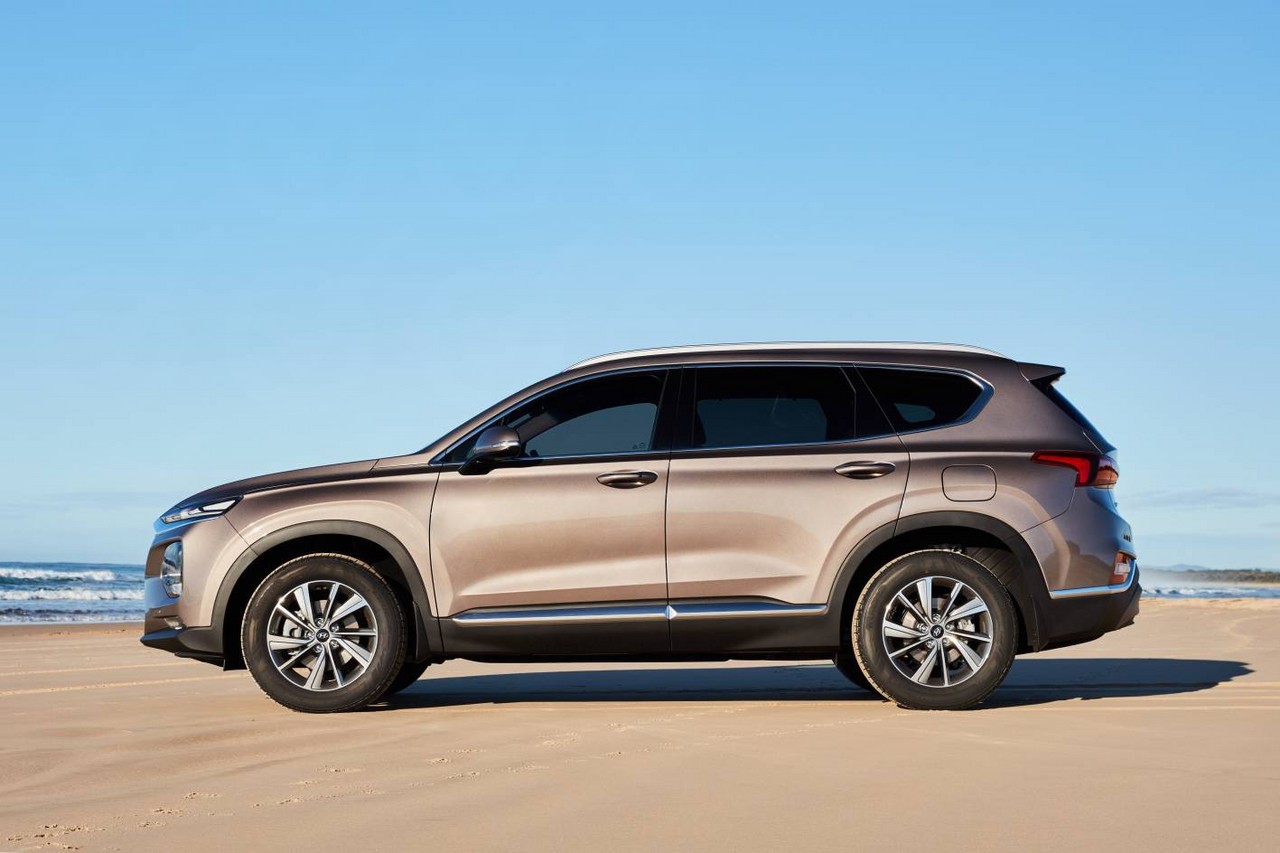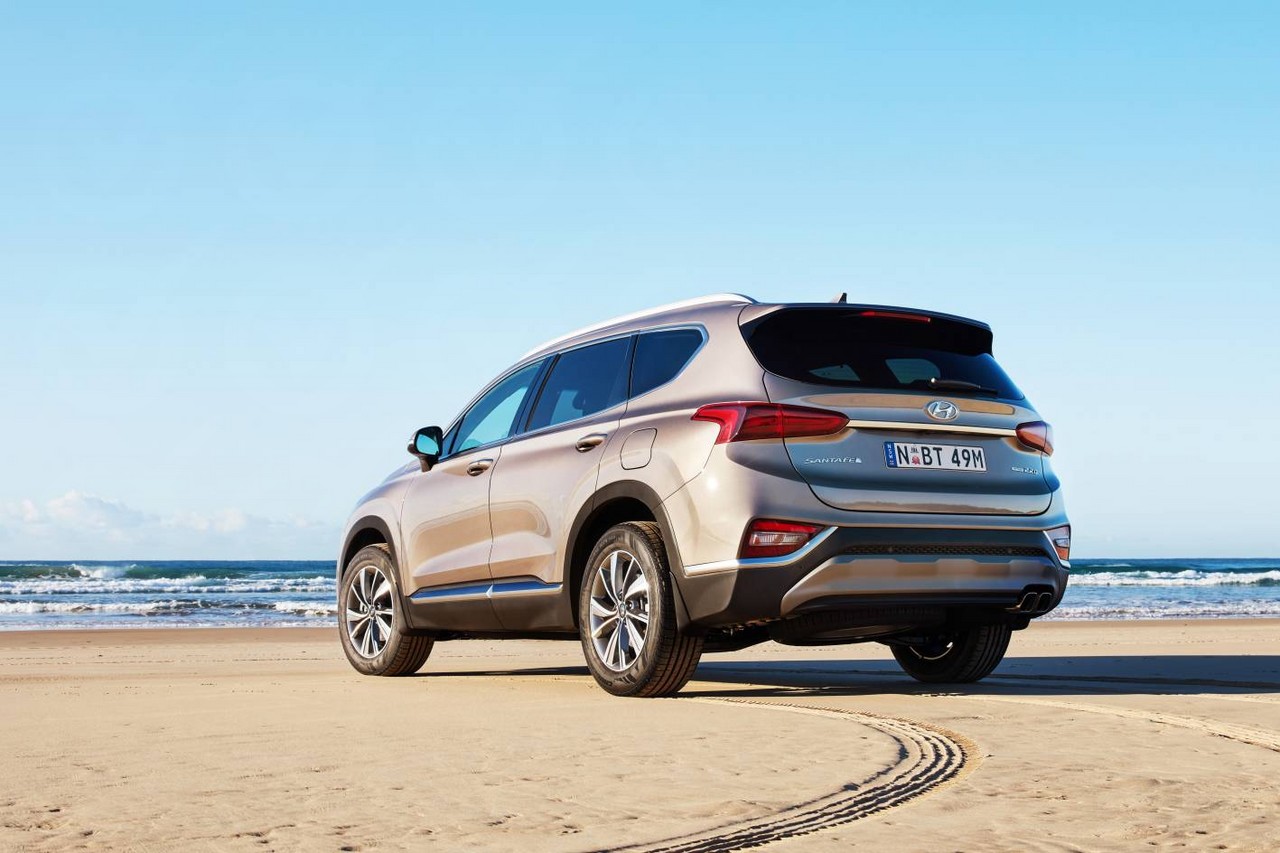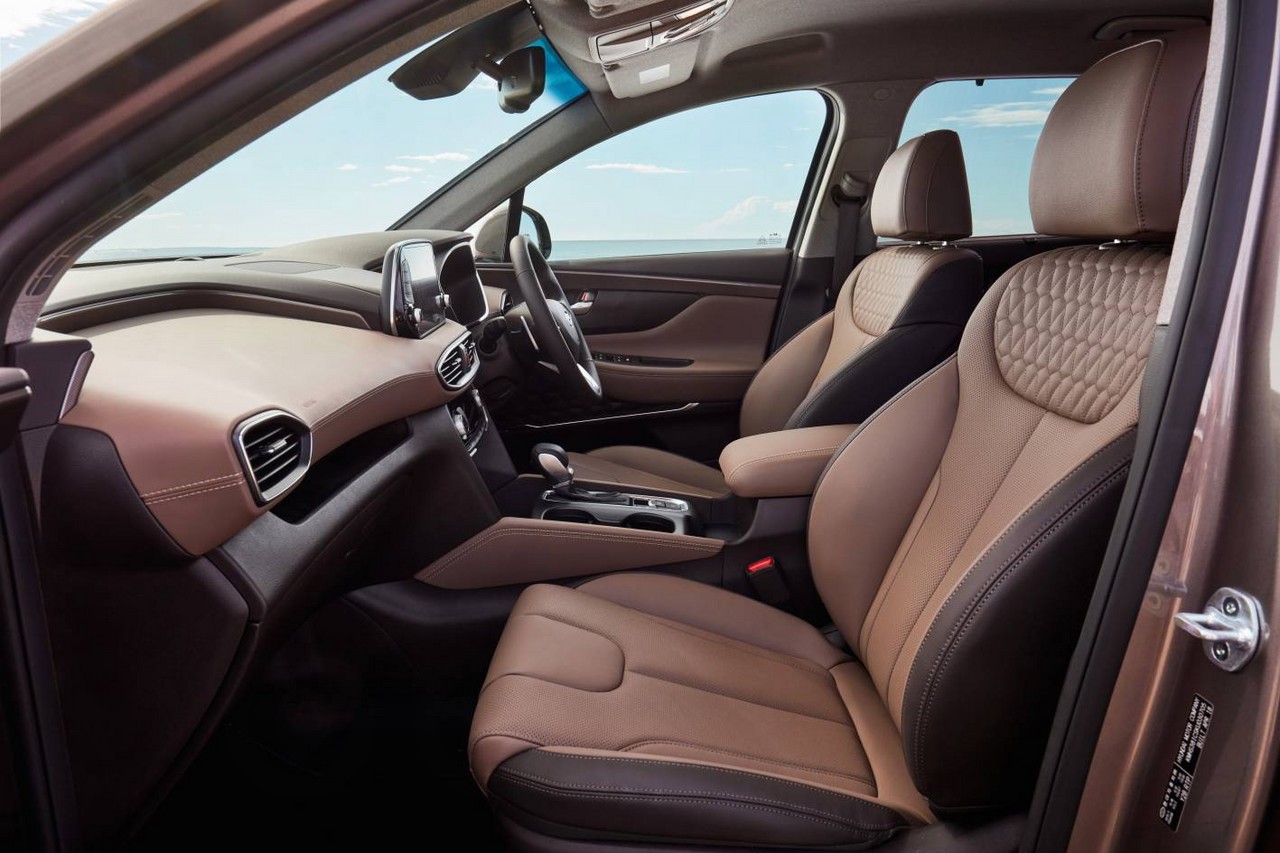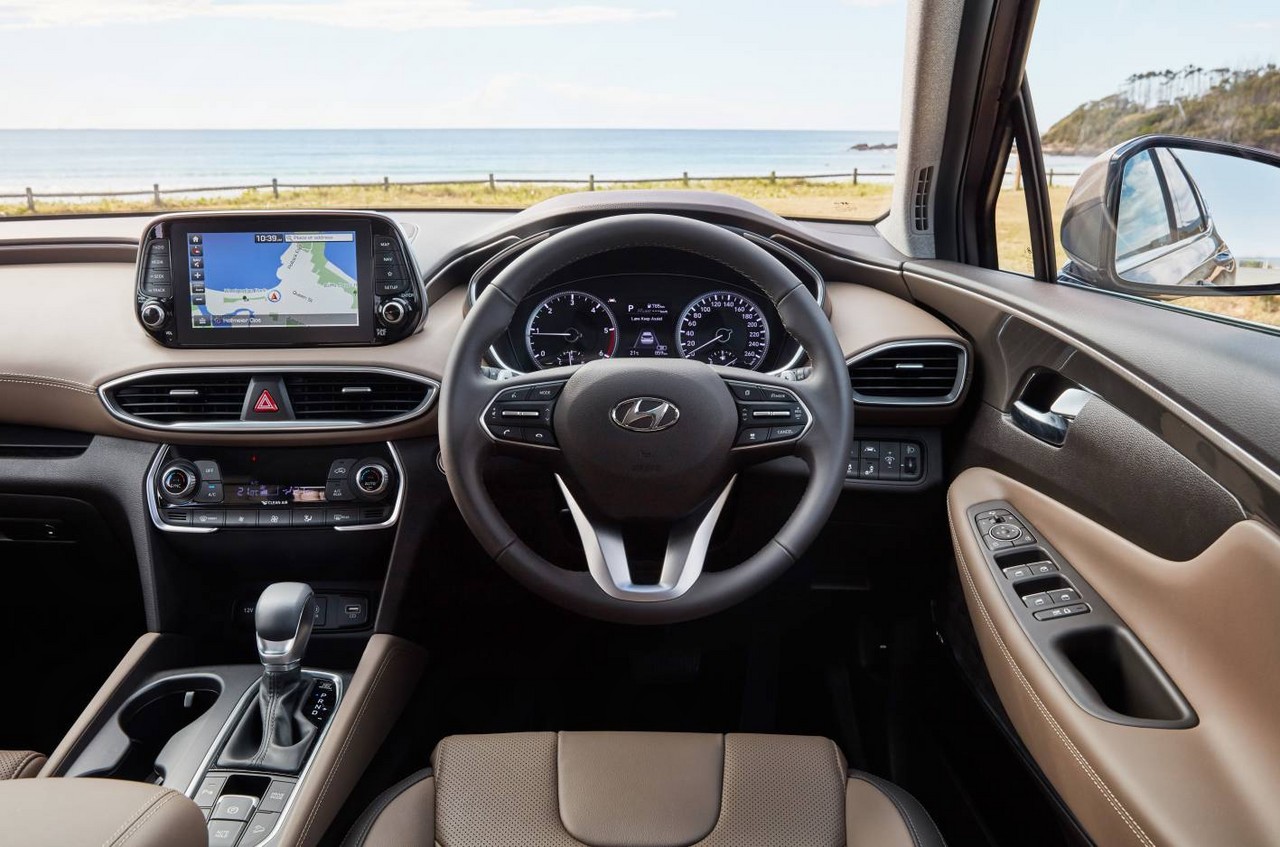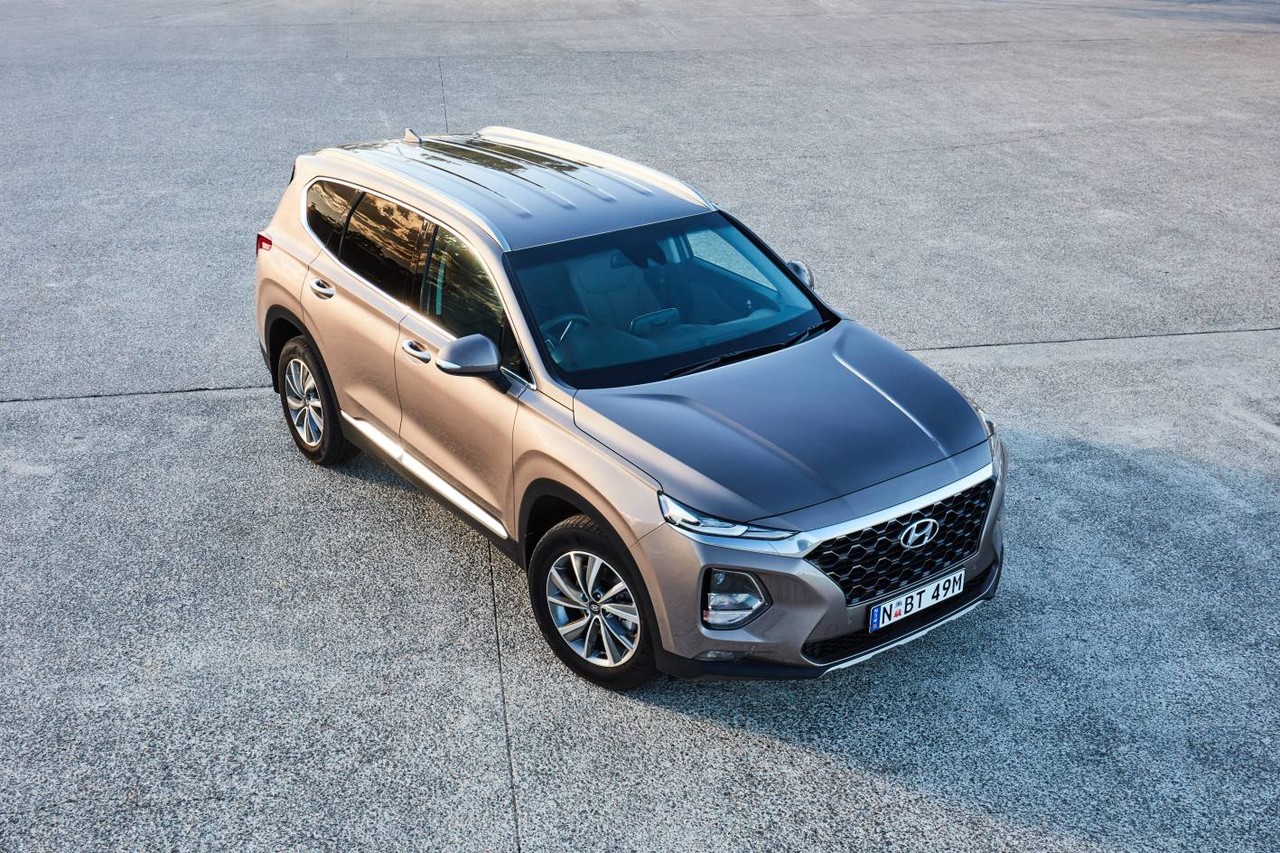
- Comfortable ride
- Bigger and stiffer body than DM Santa Fe predecessor
- Active safety technologies fitted as standard
- Five year, unlimited kilometre warranty
- 2.2-litre turbo diesel engine is responsive…
- … but noisy at idle and when accelerating
- 2.4-litre petrol engine struggles, particularly when laden
- No front-wheel drive or V6 petrol options
- Light steering lacks feel
- For Elite and Highlander, leather seats are firmer and flatter than cloth seats in Active
- For Highlander, panoramic sunroof reduces headroom
- No third-row airbags
Overview
Released in Australia in July 2018, the Hyundai TM Santa Fe was a seven-seat, all-wheel drive SUV. Manufactured in Ulsan, South Korea, the fourth-generation Hyundai TM Santa Fe was powered by 2.4-litre petrol and 2.2-litre turbo diesel petrol engines and available in Active, Elite and Highlander editions (see table below).
Theta II and R engines
Of the engines,
- The 2.4-litre G4KJ (‘Theta II’) petrol engine had an aluminium block and cylinder head, fracture-split sinter-forged connecting rods, direct fuel injection, hollow stainless-steel double overhead camshafts, four valves per cylinder, variable intake and exhaust valve timing (Hyundai’s D-CVVT), a two-stage variable induction system (VIS), a compression ratio of 11.3:1 and a stainless steel exhaust manifold; and,
- The 2.2-litre D4HB (‘R’) diesel engine had an aluminium block and cylinder head, common-rail direct injection with piezo-electric injectors, a variable geometry turbocharger, double overhead camshafts (chain-driven), four valves per cylinder, exhaust gas recirculation, a close-coupled diesel particular filter and a compression ratio of 16.0:1. The engine complied with Euro 5 emissions standards.
| Variant | Edition | Engine | Trans. | Peak power | Peak torque |
|---|---|---|---|---|---|
| 2.4 GDI | Active | 2359 cc petrol I4 | 6sp auto | 138 kW at 6000 rpm | 241 Nm at 4000 rpm |
| 2.2 CRDi | Active, Elite, Highlander |
2199 cc turbo diesel I4 | 8sp auto | 147 kW at 3800 rpm | 440 Nm at 1750-2750 rpm |
All-wheel drive system
For all Australian delivered vehicles, the TM Santa Fe had Hyundai’s ‘HTRAC’ (‘Hyundai Traction’) on-demand all-wheel drive system which provided variable torque distribution and braking power at the front and rear wheels. According to Hyundai, the torque distribution changed with the drive mode and was displayed in the instrument cluster –
- In Sport mode, up to 50 per cent of the engine torque’s was sent to the rear wheels;
- In Comfort mode, up to 35 per cent of the engine’s torque was sent to the rear wheels;
- In Eco mode, power was only sent to the front wheels; and,
- In slippery conditions, torque was distributed to all four wheels automatically.
Dimensions and body
Compared to the Hyundai DM Santa Fe which it replaced, the Hyundai TM Santa Fe was 80 mm longer (at 4770 mm), 10 mm wider (1890 mm), 10 mm lower (1680 mm, or 1705 including roof rails) and had a 65 mm longer wheelbase (2765 mm); ground clearance was 185 mm. According to Hyundai, luggage capacity was 130 litres behind the third row seats, 547 litres when the third row seats were folded down and 1625 litres when both rear rows were folded down. The second row seats could also slide 300 mm to vary space in the second and third rows.
Relative to the Hyundai DM Santa Fe , body tensile strength for the TM Santa Fe increased by 14.3 per cent to 67.0 kgf/mm2and torsional stiffness increased by 15.4 per cent to 31.5 x 104kgf*m2/radian. In part, these changes were achieved through:
- The use of high-strength steel for 57 per cent of the body (compared to 42 per cent for the DM Santa Fe);
- The use of hot stamping for forming structural sheet metal was applied to 15 components (compared to six for the DM Santa Fe); and,
- Larger weld diameters.
Suspension
The Hyundai TM Santa Fe had MacPherson strut front suspension and multi-link rear suspension. For the TM Santa Fe,
- Aluminium front knuckles and rear carrier mountings reduced unsprung weight by 3.6 kg and 5.6 kg, respectively (per wheel);
- The springs and dampers for the rear suspension were oriented vertically for longer travel and greater ride comfort;
- Multiple shock reduction dampers at the upper mounts of the front struts and rear dampers reduced noise and vibration; and,
- Thicker rear cross-member bushes improved ride quality and reduced road noise.
Steering
The Hyundai TM Santa Fe had rack-and-pinion steering with Hyundai’s ‘Rack-Mounted Motor-Driven Power Steering (R-MDPS, i.e. electric power assistance) which varied steering weight according to vehicle speed. The Hyundai TM Santa Fe had a turning circle of 11.42 metres, while the steering wheel required 2.53 turns from lock-to-lock.
Safety equipment
Standard safety equipment for the Hyundai TM Santa Fe included dual front airbags, front seat-mounted side airbags, curtain airbags for front- and second-row occupants, ABS, electronic brake force distribution, brake assist, electronic stability control, traction control and, for the front and outer second row seatbelts, pre-tensioners and load limiters.
As standard, the Hyundai TM Santa Fe was equipped with the following ‘Hyundai SmartSense’ active safety and driving assistance technologies –
- Forward Collision-Avoidance Assist (FCA) with pedestrian and cyclist detection: operating at speeds above 8 km/h, the driver initially receives visual and acoustic warnings if there was a collision. In its second stage, the brakes would be applied automatically if the collision risk persisted and the driver had not responded. In its third stage, maximum braking force would be applied;
- Smart Cruise Control (SCC) with Stop and Go: when cruise control was activated, SCC used the front radar sensor and windscreen-mounted sensor to monitor the speed and distance of vehicles ahead of the Santa Fe. As such, SCC could maintain a safe distance from the vehicle ahead, up to the pre-set cruising speed. In stop/start traffic, the stop & go function could bring the vehicle to rest and, if the vehicle had been stationary for less than three seconds, could automatically accelerate when the traffic ahead began to move. If the vehicle had been stationary for longer than three seconds, the driver would need to depress the accelerator for the vehicle to move;
- Blind-Spot Collision-Avoidance Assist (BCA): operating at speeds above 30 km/h, BCA used the windscreen-mounted sensor to detect the Santa Fe’s position within its lane, while the rear radar sensors could detect vehicles that were adjacent and in the driver’s blind spot. To warn the driver, BCA would display a visual alert in the door mirror which corresponded to the side of the Santa Fe on which the vehicle was detected. If the driver began to drift into an occupied lane or turned the steering wheel in the direction of the blind-spot hazard, the brakes on the opposite side of the vehicle would be applied to resist the lane change;
- Rear Cross-Traffic Collision-Avoidance Assist (RCCA): when the Santa Fe was reversing at speeds below 10 km/h, RCCA used the rear radar sensors to scan a 180 degree area behind the vehicle. If approaching traffic was detected, visual and audible warnings would sound and the brakes would be applied automatically;
- Driver Attention Warning (DAW): active at speeds between 60 km/h and 180 km/h, DAW monitored lane position, steering inputs, brake pedal inputs and the time since the driver had last taken a break. If inattentive driving was detected, an ‘Attention Level’ display on the instrument panel would continually decrease and would recommend that the driver take a break;
- Active Lane Keeping Assist (LKA): at speeds above 60 km/h, Active LKA used the windscreen-mounted camera to detect lane markings and operated where lane markings on both side of the vehicle could be detected. If the Santa Fe departed from its lane without the indicators having been activated, steering intervention would assist the vehicle to track in the centre of the lane;
- Lane Departure Warning (LDW): at speeds above 60 km/h, LDW would issue audible and visual warnings if the Santa Fe departed from its lane without the indicators having been activated; and,
- High Beam Assist (HBA): at night and when driving at speeds over 40 km/h, HBA used the windscreen-mounted camera to detect street lights, the headlights of oncoming vehicles and the tail-lights of vehicles being followed. If other vehicle light sources were detected, HBA would automatically switch from high to low beam.
Beyond this, the Hyundai Santa Elite and Highlander were further equipped with:
- Rear Occupant Alert (ROA): used an ultrasonic sensor to monitor the rear seats and would initially remind the driver to check the rear seats by displaying a message on the central instrument cluster display when the engine was switched off. If movement was detected in the rear seats after the rear doors had been opened and then closed, the horn would sound and the lights would flash when the vehicle was locked. The system would also activate if children accidentally locked themselves in the car; and,
- Safe Exit Assist (SEA): used the rear radar sensors to detect traffic approaching from behind the vehicle and would warn the driver when a door which had an automatic Power Child Lock was opened. If the driver attempted to unlock child lock doors and the system detected approaching traffic, the vehicle would maintain the child lock and issue audible and visual warnings.
Euro NCAP testing: 2018 Hyundai TM Santa Fe
In Euro NCAP testing , the Hyundai TM Santa Fe received a five star safety rating which included a 94 per cent adult occupant protection rating and an 88 per cent child occupant protection rating. In the frontal offset test, occupant protection was generally rated as good, although chest protection for the driver and lower right leg protection for the front passenger were rated as adequate (i.e. a slight risk of serious injury). In the side impact test, protection of the chest and torso were rated as good, though head protection was rated as adequate. In the more severe pole test, head and chest protection were rated as adequate.
Wheels, tyres and brakes
Wheel and tyre combinations for the Hyundai TM Santa Fe were as follows –
- Active: 17 x 7.0J ten-spoke alloy wheels in ‘Real Steel Grey’ finish with 235/65 R17 104H tyres;
- Elite: 18 x 7.5J ten-spoke alloy wheels in ‘Dark Metal’ with machined highlights and 235/60 R18 107V tyres; and,
- Highlander: 19 x 8.0J ten-spoke alloy wheels in ‘Dark Hyper Silver’ with 235/55 R19 101V Continental ContiSportContact 5 tyres.
Across the range, the Hyundai TM Santa Fe had 320 mm by 28 mm ventilated front brake discs and 305 mm by 11 mm solid rear discs.
Features: Hyundai TM Santa Fe Active
Standard features for the Hyundai Santa Fe Active included a seven-inch touchscreen, USB and 3.5 mm auxiliary input, a USB charging port, two 12 volt power outlets (centre console and luggage area), Bluetooth mobile phone connectivity with voice recognition and audio streaming, Apple CarPlay and Android Auto smartphone integration, a six speaker sound system, air conditioning, front fog lights, LED daytime running lights, dusk-sensing headlights, 60:40 split and folding second row seats, 50:50 split and folding third row seats, a leather-wrapped steering wheel and gear knob, remote central locking, power adjustable and heated door mirrors, power windows, tilt and telescopic steering wheel adjustment, a height adjustable driver’s seat, an electric parking brake, a trip computer (with a 3.5-inch LCD) and an immobiliser.
As standard, the TM Santa Fe was equipped with ‘Hyundai Auto Link’ which enabled owners to access the Santa Fe’s ‘smart computer’ through their mobile phones (via Bluetooth) to monitor vehicle data such as real-time diagnostics, tyre pressure, driving history statistics, parking management, service scheduling and access to roadside assistance.
Features: Hyundai TM Santa Fe Elite
Compared to the Hyundai Santa Fe Active, the Santa Fe Elite was further equipped with an eight-inch touchscreen with satellite navigation (including 3D maps, SUNA live traffic updates and a lifetime map update plan), Infinity surround sound system with ten speakers (including subwoofer), digital radio tuner (DAB+), dual-zone climate control air conditioning and a cooled glovebox, leather appointed seats, a ten-way power adjustable driver’s seat, an eight-way power adjustable front passenger seat, rain-sensing wipers, steering wheel gearshift paddles, proximity key (i.e. keyless entry), power folding door mirrors, push-button start, an electrochromatic rear-view mirror, rear window sunshades, rear privacy glass and LED courtesy lights (in the front door handles).
The Hyundai Santa Fe Elite and Highlander were also equipped with a ‘Smart Power Tailgate’ which would automatically unlock when the Smart Key was detected in its proximity. The tailgate could also be opened or closed by pressing the Smart Key button, or by pressing the buttons on the tailgate.
Visually, the Santa Fe Elite and Highland could be identified by their ‘carbon grey’ front grille finishes, satin chrome door handles and satin chrome finishes side garnish inserts.
Features: Hyundai TM Santa Fe Highlander
The range-topping Hyundai Santa Fe Highlander was distinguished by its ventilated front seats, heated front and outer second row seats, a fourteen-way power adjustable driver’s seat, driver’s seat memory settings, directional LED headlights, LED front fog lights, a heated steering wheel, door mirrors with automatic dipping on reverse, a seven-inch LCD in the instrument panel for trip computer information (Hyundai’s ‘supervision’ cluster), ‘acoustic’ laminated windscreen glass, panoramic glass sunroof, LED interior lighting and a wireless inductive charging pad (Qi standard) for mobile phones.
Other standard features for the Hyundai Santa Fe Highlander included:
- A Surround View Monitor (SVM) which provided a range of exterior camera views – including a top-down view – that could be selected by pressing a button adjacent to the transmission gear selector;
- Park Assist: would overlay parallel, perpendicular and reverse parking guidelines on the camera image; there were also dynamic on-screen parking guidelines that would swivel as the steering wheel was turned;
- Advanced Smart Parking Assist System (ASPAS): could steer the vehicle into 90-degree and parallel parks while the driver controlled vehicle speed. ASPAS also included an exit function for parallel parks;
- A head-up display (HUD) – which projected driving and safety information – that had an eight-inch (diagonal) projected image size and a luminance of 10,000 candela/m2; and,
- Hyundai Auto Link Premium which enabled the driver to use their mobile phone to control engine start and stop, door locking, hazard warning lights, horn settings and, once the engine had started, cabin temperature and defroster operation.
The Hyundai Santa Fe Highlander could be identified by its LED tail-lights.
Specifications
